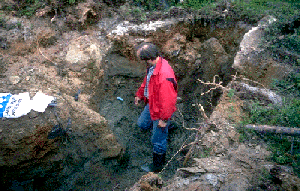Quaternary Deposits/Bedrock
Rationale
By studying the chemical composition and spatial variability of
Quaternary deposits (Figs.1,2) or bedrock (Fig. 3), one gets an impression
of the
natural geochemical patterns upon which any anthropogenic contribution
may be superimposed. It is of crucial importance in any environmental
investigation to document what the natural elemental levels and
variation are, in order to be able to say how significant the
man-made overprint really is.
Advantages
Gives the natural geochemical picture.
Drawbacks
Requires digging (deep) through the soil, or (hand-held) drilling
equipment to take the samples.
Spatial geochemical variability (horizontal and vertical) can
be great (veins, contacts, superimposed tills, ...).
ASSISTED DIGGING TO EXPOSE QUATERNARY DEPOSITS
![[cd2-12]](/Kola/cd2-12_.gif)
(Photo: G. Kashulina)
Fig. 1: Excavator digging through the deep soil to uncover the moraine
deposit to be sampled.
|
QUATERNARY GEOLOGIST AT WORK (C5)

(Photo: G. Kashulina)
Fig. 2: Excavated pit for study and sampling of Quaternary deposits.
|
BEDROCK MAP
![[GEOLMAP.GIF]](/Kola/geolma_.gif)
(Map: Ø. Nordgulen)
Fig. 3: Simplified map of the solid geology of the Kola Peninsula, showing
various geological terranes. The Varanger and Rybachi Peninsulas consist of
Late Paleozoic sedimentary rocks (yellow). Late Archean greenstone belts
(pale green) are found at Bjørnvatn, Olenegorsk, and Kolmozero-Voronya. The
Keivy terrane is Early Proterozoic in age (blue-green). The
Polmak-Pasvik-Pechenga-Imandra-Varzuga-Ust'Ponoy greenstone belt (dark green)
is of Early Proterozoic age. Granite and granodiorite intrusions of the
Neiden type are shown in dark brown, those of the Nattanen type in red.
Paleozoic
alkaline intrusions are shown in magenta. Hetta granitoids (light brown)
and Jergol gneiss (light orange) are found within the Karelian Province
(medium green)
near the Finnish-Norwegian border. For more information, consult Roberts, R.
and Norgulen, Ø., eds., 1995. Geology of the eastern Finnmark-
western Kola Peninsula Region. NGU Spec. Publ., no. 7). Blue stars indicate
the location of major townships.



![[cd2-12]](/Kola/cd2-12_.gif)

![[GEOLMAP.GIF]](/Kola/geolma_.gif)